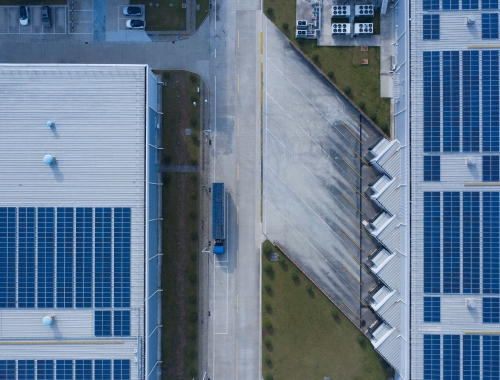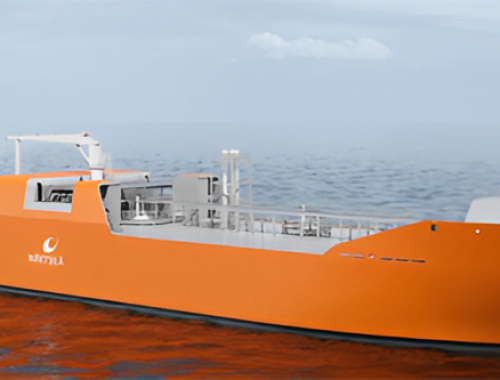Inside Aberdeen’s CO2 electrocatalyser concept
SUMMARY
Angel Cuesta Ciscar and Panos Kechagiopoulos have come up with concept for converting CO2 into hydrocarbons that would store and transport hydrogen.
By Callum CyrusPOSTED IN:
A team of university scientists believe CO2 emissions could be broken down and fused through catalysis with oxidated hydrogen molecules, creating a stockpile of hydrocarbons that could be used to fuel energy storage facilities.
Led by University of Aberdeen professor Angel Cuesta Ciscar, who specialises in natural and computing sciences, and engineering school doctor Panos Kechagiopoulos, the project will break new ground by exploring how an electrochemical reaction could turn CO2 into a container for carrying hydrogen, contributing to the decarbonisation of important industrial processes.
Kechagiopoulos adds that the process could also make hydrogen easier to transport, as there would be no need to build hydrogen pipelines prone to corrosion and gas leaks.
“If you chemically capture hydrogen in a hydrocarbon then you are transporting the liquid in normal conditions, which is a lot easier – we already have the infrastructure and know how to do so,” Kechagiopoulos told Gas Pathways.
In energy transition terms, the clincher is that a hydrocarbon catalyser could be powered using renewable forms of electricity, whether solar, hydro dams or – as in the UK – an abundance of onshore and offshore wind farms. The technology’s potential is certainly multifaceted, helping to at once stabilise hydrogen storage, pull carbon out of the atmosphere, and redeploy renewables as a common energy fuel source.
Ciscar said: “A reduction cannot occur without a simultaneous oxidation, reducing carbon dioxide to hydrocarbon necessarily requires oxidising something else. From a purely chemical point of view, hydrogen is the most straightforward option, although it would require hydrogen to be produced elsewhere in sufficiently high quantity and using renewable energy.”
Of course, there needs to be plentiful CO2 stock for the plasma catalyser to draw upon. The obvious source would be carbon capture and storage (CCS) systems, potentially giving IOCs an immediate use case for CO2 stored in exhausted oil and gas reservoirs.
“The concentration of CO2 in Earth’s atmosphere is very low, our electrolyser would need to be located next to a concentrated source of CO2,” Kechagiopolous said. “This could be a CCS system or the effluents of carbon intensive industrial processes, like steel or cement production.”
Ciscar is an electrochemist, while Kechagiopolous specialises in plasma catalysis. Their idea took shape one day when they met for coffee. A scientific paper had discussed using a plasma field as the electrolyte in an electrochemical cell, which made the Aberdeen scientists wonder whether a new catalyser technique, merging their two disciplines, might be possible.
“At some point we concluded that it would be worth trying to run a plasma electrocatalytic system, in which the rate of plasma catalytic reactions could be accelerated by applying an electric field across the catalyst-plasma interface,” Ciscar told Gas Pathways. “Shortly after this informal chat, the EPSRC launched [a research funding call] and we decided to sit down, think more carefully about the problem, and draft a case for support.”
The team secured a £250,000 research grant from the UK’s innovation council to try out its concept in a pilot study. Kechagiopoulos says the money was not easy to come by – the proposal won out from a highly competitive arena. He added: “We were obviously delighted because we knew that this was necessarily going to be a very competitive call with a very low rate of success and that even very good proposals would not make it to the final list.”
Having secured the funding, the team is now putting the finishes touches to its research and development schedule. It is too early to say with certainty how the project might progress – there are too many moving parts that will influence the timeframe, Ciscar said – but the team has a few preliminary targets it will aim for.
“Nobody, as far as we know, has ever tried anything like this. So it could be everything works at the first attempt, or it may be that we need to do very different things until we find out what really works,” he said. “I would be happy if we had by the end of the first year some proof of concept at the lab scale. In the second year, we could work towards making a small prototype.”
One of the biggest challenges will be building the plasma itself. The plasma will act as a charged palette for storing concentrated ions of every gas that will be run through the catalyser, Kechagiopolous explained. Not only could the plasma create hydrocarbons from hydrogen and CO2, but it could also be converted to strip down carbon monoxide, leaving an oxygen residue for specialist use cases.
“Essentially, you have electrons that have collided with molecules. By these collisions they have essentially kicked out more electrons from the molecules and, essentially, you are left with ionised versions of the original molecules,” Kechagiopolous said.
“Because a plasma is a very reactive state – it is like a soup that everything is colliding with, [almost] like a billiard ball. You eventually produce ions of every possible species that you want in that soup, at different concentrations. However, some ions might be more populated, and some will be less populated.
“Essentially whatever gases we decide to use as reactive gases, these will also exist at some point in the plasma in an ionised form.”
Using reactive and secondary gases is necessary, because to reduce one chemical through catalysis, the machine must simultaneously create an oxidation effect in another part of the chemical mix. Another key draw of the Aberdeen electrolyser concept is that by overlaying an electric charge onto the plasma, the reactive efficacy of the catalyser could be significantly improved.
“There are electrolysers that use liquid electrolytes to reduce or generate a lot of carbon dioxide or folic acid. Again, the problem here is the cost of the electrolyser itself, and the cost of the energy,” Ciscar said. “What we are trying to do is to see if we can achieve a similar effect with less expensive materials, because the plasma should be so reactive that maybe you do not need so much energy or high temperature, as you would do with normal electrolysers.”








